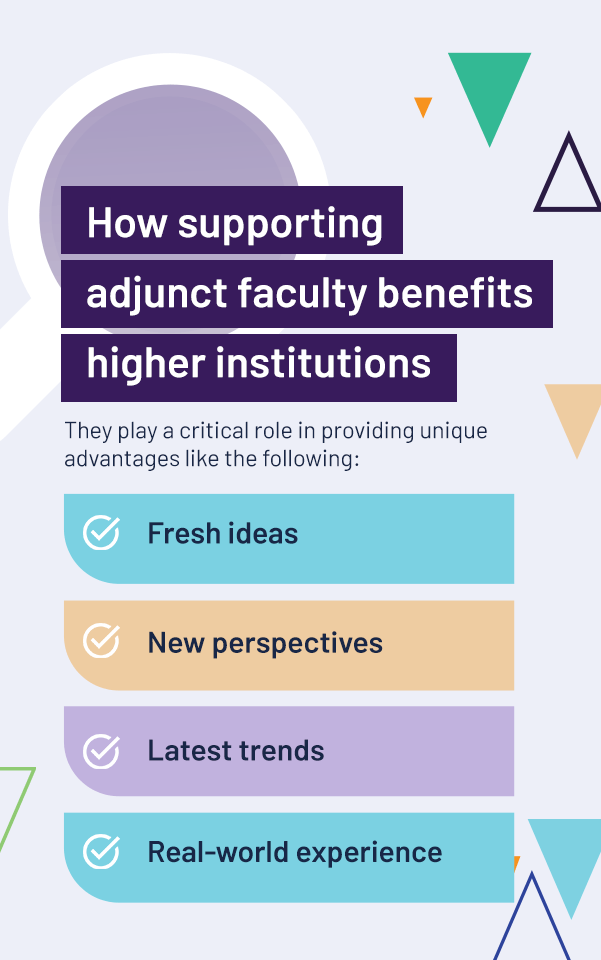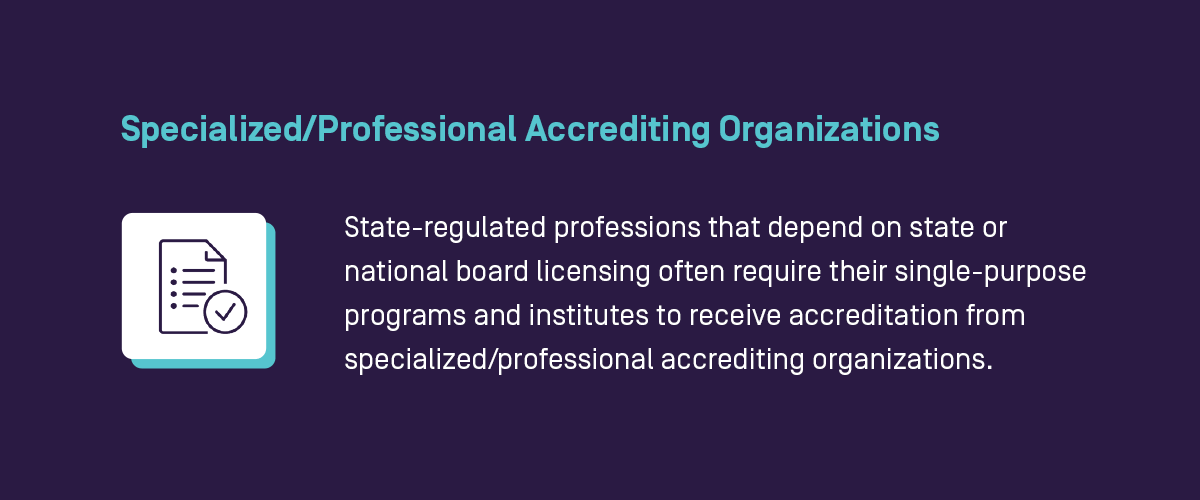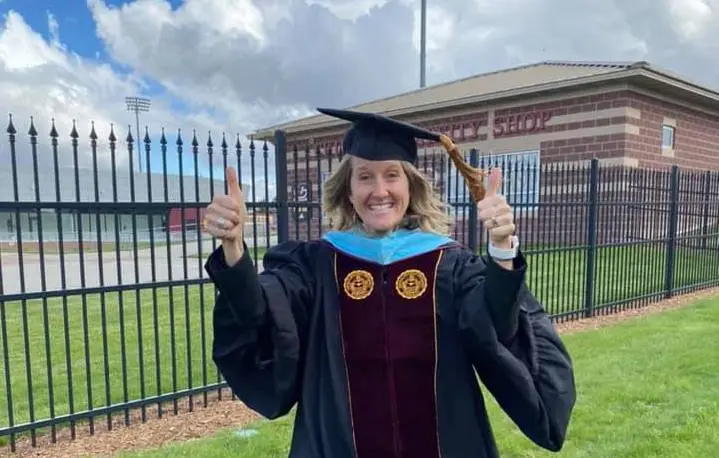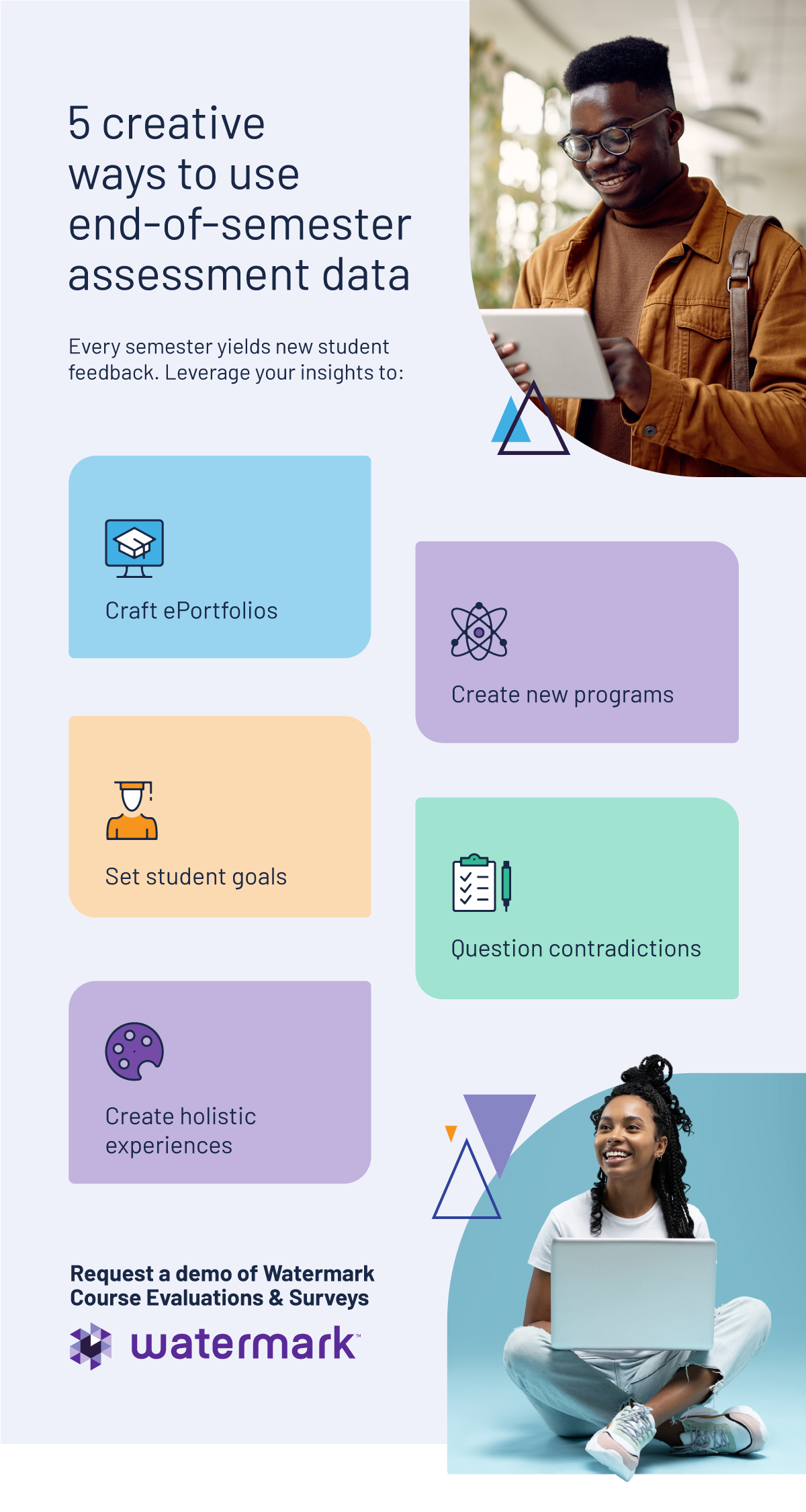
With 70 percent of college faculty working as adjuncts — a figure shared by the American Association of University Professors (AAUP) — it’s clear that part-time educators play a critical role higher education landscape. Adjuncts bring fresh ideas, real-world expertise, and much-needed flexibility to their institutions. But too often, they’re underfunded and lack the support they need to feel fully connected and effective in their roles.
This lack of resources can lead to frustration and impact their contributions. That’s why institutions must focus on supporting adjunct faculty. It’s a key way for community colleges and universities to build a stronger, more engaged faculty. When institutions invest in their adjuncts, everyone benefits — the faculty, students, and the campus community.
How supporting adjunct faculty benefits higher institutions
Although adjunct faculty is only temporary, they may bring lasting results for higher education institutions and their students’ success. They play a critical role in providing unique advantages like the following.
Fresh ideas
Adjuncts often come from different professional backgrounds or actively work outside academia. Their dual exposure is highly beneficial. Adjunct professors can bring fresh approaches, creative teaching methods, and up to date content they’ve learned in their industry and creatively apply them to the classroom. Fresh ideas help keep classes lively and make learning more relevant to what’s happening right now.
New perspectives
Because adjuncts come from such varied experiences, they add unique points of view to the classroom. Their diverse backgrounds can add a fun challenge. New perspectives in the classroom may encourage students to think more critically and explore different ways of addressing issues. Having an adjunct professor may even help students engage in more open and enriching discussions.
Latest trends
Many adjuncts are still in the field, so they’re tuned into what’s currently happening. Having exposure to the latest trends is especially valuable in fast-changing fields like technology or business — where staying on top of trends is key. Students of adjunct professors can get insights to help keep them ahead of the curve.
Real-world experience
With adjuncts’ firsthand knowledge, they can share real-life practical examples and advice that bring theories to life. Students get to see how what they’re learning applies in real-world settings. Getting this point of view helps make their education feel more meaningful and connected to their future careers.
The challenges of being part-time faculty
As part-time faculty, adjuncts may face some tough yet common challenges in their roles.
Low pay
Adjuncts are typically paid far less than full-time faculty. Some research suggests that part-time faculty earn a median of $3,900 per course between 2022 and 2023. The low pay may reflect only their classroom time and not all the behind-the-scenes work like grading, preparing lessons, or meeting with students. An hourly wage or compensation per course may make some adjuncts feel undervalued.
Job insecurity
Most adjuncts are hired on short-term contracts that are renewed, or not, each semester. This means that they’re not full-time employees at an institution — so there’s little job stability compared to full-time faculty. The uncertainty can be stressful and makes it hard for them to plan ahead or feel secure in their roles.
Limited resources
Unlike full-time professors, adjuncts usually don’t have access to things like office space, research funding or even the same teaching resources. The limited access to resources can make it challenging to perform their duties. Limited resources can also make it tough to support their students fully or pursue their own professional development within the college.
Isolation
Adjuncts often teach at multiple schools, so it’s easy to feel disconnected from any one campus community. As part-time faculty, they may not always be included in departmental meetings or events. As a result, some adjuncts may feel isolated — which can make it hard to build relationships with their colleagues.

Ways to support adjunct faculty
Supporting adjunct faculty can be challenging. It’s easy for them to feel isolated from other full-time faculty members, which may affect their teachings. Here are several ways administrators can support their part-time faculty to ensure institutional and student success.
1. Create a dedicated adjunct faculty space
Address one of the major challenges of adjuncts and provide them with a dedicated space. A dedicated space just for adjuncts can make a huge difference in helping them feel welcomed and valued on campus. This space doesn’t have to be fancy — it just needs the basics like desks, computers, and maybe a lounge area.
A few benefits of having a dedicated adjunct space may include:
- Provides a quiet area to work or prepare for classes
- Offers a place to meet students for office hours
- Encourages networking and camaraderie with other adjuncts
- Enhances the sense of belonging on campus
It’s a small gesture with a big impact. It helps adjuncts feel they truly belong and are valued as part of the campus culture.
2. Establish supportive onboarding programs
Starting a new teaching role can be overwhelming, especially for adjuncts juggling multiple campuses or jobs. Help ease the transition with an adjunct support onboarding program. An onboarding program can help part-time faculty feel prepared and connected from the start.
A strong onboarding program could involve:
- Campus orientation and facility tours.
- Informational workshops on teaching tools and campus resources.
- Social events or networking sessions with other faculty.
- Guidance on policies, classroom procedures, and student expectations.
These programs can give adjuncts the tools they need to succeed — from understanding policies to comprehending classroom technology. Onboarding sessions that include a meet-and-greet with other faculty can also go a long way toward making adjuncts feel part of the team.
When part-time faculty are brought up to speed quickly, they can focus on teaching and supporting students.
3. Understand part-time faculty goals
Taking time to learn about each adjunct’s goals shows they’re valued as more than just temporary hires. Every faculty member is different and thus has different goals. Some adjuncts may be focused on teaching experience, while others might be exploring a path to full-time academia or balancing teaching with other career roles.
Checking in with adjuncts to discuss their goals helps administrators understand where they’re coming from. Knowing this, administrators can provide tailored support. For instance, an adjunct interested in professional development might benefit from workshop opportunities, while another might appreciate guidance on teaching more advanced classes.
A few areas one can discuss could be:
- Professional development and growth opportunities.
- Teaching preferences or areas of expertise.
- Career aspirations within academia or other fields.
- Resources or support that would help them succeed.
4. Offer development opportunities
Investing in adjunct faculty development can bring enormous benefits. Even if they’re only on campus for a semester, offering training and growth opportunities allows adjuncts to stay current and feel empowered in the classroom.
Types of development opportunities that can benefit adjuncts can include:
- Needs-based workshops on teaching strategies and tools.
- Training for digital or hybrid classroom environments.
- Networking events with other faculty and industry experts.
- Access to conferences, lectures, or continuing education resources.
Development opportunities can help boost adjunct faculty members’ confidence — and it may waterfall into improving students’ learning experience.

5. Assign experienced mentors
Having a mentor can be invaluable for adjuncts, especially those who are new to teaching or unfamiliar with the institution. A mentor is a friendly face who will be the adjuncts’ pillar of support. They can even help adjuncts feel less isolated and more connected to the faculty community.
Mentorship can be as simple as regular check-ins over coffee or a quick chat after class — but the impact can be huge. A mentor can be seen as a safe space for adjuncts to ask questions, get feedback, and feel like they have someone on their side.
Mentors where many hats — they:
- Answer questions and provide campus orientation.
- Offer advice on classroom management and workload balancing.
- Help with institution-specific processes and resources.
- Provide feedback on teaching methods and growth.
6. Foster a supportive campus culture
A supportive culture can make quite an impact on how adjuncts feel. Creating a supportive campus culture means recognizing them as valuable contributors — not just part-timers passing through. Adjuncts who feel included and respected may help improve their role engagement and satisfaction.
Simple gestures go a long way in cultivating a positive environment. Higher education institutions can create such an environment by:
- Recognizing adjuncts’ achievements and contributions.
- Inviting adjuncts to faculty meetings and events.
- Promoting teamwork and peer support.
- Encouraging open discussions and feedback from all faculty.
Doing so can help adjuncts see that their presence is valued. They may be more likely to go the extra mile for their students and the institution as a whole.
7. Collaborate with adjunct faculty
Adjunct faculty often bring unique, real-world insights to campus, but their voices are rarely heard in decision-making. However, collaborating with them can allow institutions to capitalize on their unique perspectives and experiences.
Here are a few ways to include an adjunct faculty member in decision-making:
- Invite them to department meetings and planning sessions.
- Include them on relevant committees or review boards.
- Ask them for input on curriculum and student engagement.
- Encourage them for feedback on faculty or institution-wide initiatives.
Adjuncts’ input can help expand course content, modify teaching techniques, or even add value to the campus environment. This collaboration doesn’t just help institutions and students — adjuncts’ sense of belonging and connection to the campus are also built. When adjunct faculty have their say, it reinforces that their contributions matter.
8. Ensure transparent, open communication
Open, transparent communication — from leaders, administrators, human resources, or faculty liaisons — can make a big difference in adjuncts’ experiences on campus. Keeping them in the loop can help them feel like part of the team and ensure their needs are met.

Maintain open communication with adjuncts by:
- Providing a clear point of contact for questions and feedback.
- Sending regular updates on institutional news and policies.
- Offering clear instructions on accessing campus resources.
- Creating channels for adjuncts to voice concerns and suggestions.
Keeping adjuncts up to date also means that they don’t have to chase down information or feel left out of important updates. There are various ways to communicate with faculty. Institutions can use regular check-ins, emails, or feedback opportunities — whichever works best. When they know what’s going on and feel heard, they may feel more secure, valued, or engaged in their work.
9. Provide equal access to resources
For adjuncts to do their best work, they need access to the same resources as full-time faculty. When institutions level the playing field by offering adjuncts access to facilities, funding or even professional development opportunities — it shows they’re valued as long-term adjunct faculty.
A few essential items an adjunct faculty member could benefit from include:
- Workspace, office supplies, and computer access.
- Teaching tools like projectors, software, and classroom support.
- Library resources, research funding, or professional memberships.
- Opportunities for training, workshops, and conference attendance.
Just a few basic resources can benefit adjuncts and students’ education quality. A commitment to equity across the board can help create a more balanced and productive academic environment.
10. Host faculty events
Faculty events are a fantastic — and fun — way to help adjuncts feel part of the campus community. This can especially be the case when they teach across multiple campuses. Hosting events such as faculty lunches, meetings, and conferences can help reduce isolation and encourage networking and collaboration among all faculty members.
Here are a few faculty event ideas:
- Faculty mixers, coffee breaks, or lunches.
- Annual faculty retreats or team-building workshops.
- Regular department meetings open to all faculty.
- Networking events to encourage interdisciplinary collaboration.
Casual settings also make it easier to share ideas and feel connected to the broader faculty network. Higher education institutions must ensure they host regular events that include adjuncts to show them they’re valued — not just as part-timers but as important members of the team.
Support adjunct faculty with Watermark
Adjunct faculty members play a critical role in each campus they teach at. Supporting them means giving them the recognition and resources they deserve — benefiting them, the students, and the institution itself. This is where Watermark can make a difference.
With Watermark Faculty Success, you can easily track and showcase everything your adjuncts contribute — whether it’s teaching, research, or community involvement. Imagine having all the data you need to understand and celebrate your faculty’s impact at your fingertips. This centralized tool makes it simple to capture key insights, streamline reviews, and support their growth, all while making accreditation reporting a breeze.
If you’re ready to make a difference for your adjuncts, request a demo today and see Faculty Success in action and how it can help you support their success from day one.
















































































































































































































































































































































































































